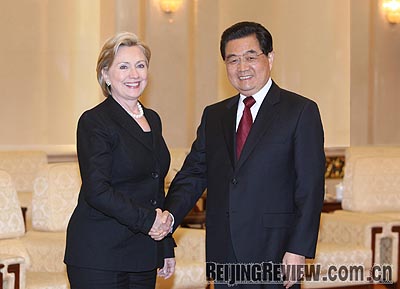| Traditionally, the U.S. secretary of state heads to Europe first, but on her first foreign trip Hillary Clinton flew across the Pacific to visit four Asian countries: Japan, Indonesia, South Korea and China. It is still too early to tell whether Washington has shifted its diplomatic focus from Europe to Asia. But it is clear that Asia has gained importance in American eyes. Because of the deteriorating global financial crisis, the United States needs to encourage every possible party to stand together and confront the economic turmoil, said Chinese observers.
 |
|
REACHING OUT: Chinese President Hu Jintao shakes hands with visiting U.S. Secretary of State Hillary Clinton before their discussion in Beijing on February 21 (YAO DAWEI) | A tour showing 'smart power'
Before her visit, Secretary Clinton made a speech at the New York-based Asia Society, laying out the new government's Asia policy. She stressed that the United States would pay continuous attention to Asian affairs and strengthen bonds with Asian leaders, so as to find a solution to the economic crisis together. She said the United States was ready to "listen."
"Secretary Clinton's Asian trip was more like a symbolic voyage, which intended to test the world's reaction by knocking at Asian countries' door," said Yang Hongxi, a researcher at the China Center for Contemporary World Studies. He pointed out that Washington was trying to create a diplomatic balance among Europe, the Middle East, East Asia and North America. "This trip shows that the Obama administration's Asian policy has basically taken shape."
This round of visits covered various topics, including bilateral relations, the nuclear issue on the Korean Peninsula, the financial crisis, climate change, clean energy, nonproliferation, counterterrorism, poverty alleviation and prevention of epidemic diseases.
"Clinton's schedule was a result of measuring all these considerations," Yang said.
She visited Japan from February 16 to 18, intending to encourage Japan's confidence in its alliance with the United States. "This was a comfort visit to Japan, telling Tokyo that Washington still regards it as a reliable ally," Yang said.
U.S. presidents and secretaries of state have the tradition to begin their visits to Northeast Asia with Japan as the first stop. In Bill Clinton's administration, Japan was comparatively neglected, said Yang, and neither Obama nor Hillary Clinton made much mention of Japan during the presidential election campaign. "This made Japan worry that it was being marginalized and the U.S.-Japanese alliance degraded," Yang said. Choosing Japan as the first stop reinforced that Japan is still America's core ally in Asia, and that it will not be isolated even if the U.S.-China relationship develops, he said.
During Clinton's visit, the two countries also exchanged views on counterterrorism, reconstruction in Afghanistan, the nuclear issue on the Korean Peninsula and the global financial crisis. They signed an accord to transfer 8,000 Marines in Okinawa to Guam. Clinton encouraged Japan to participate in more UN peacekeeping missions and suggested that the Japanese self-defense fleet add foreign ships to its escort list.
In the meantime, Washington is preparing a backup plan by keeping in contact with the opposition party that might win the parliamentary election this fall.
|
